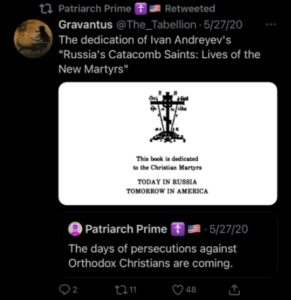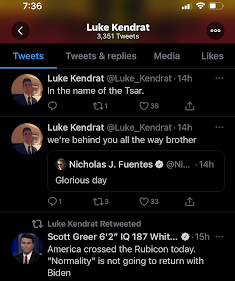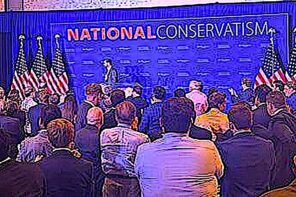When insurrectionists stormed the Capitol building on January 6, 2021, most news reports focused on those who were Pro-Trump evangelicals and their ties to white Christian nationalism. Yet, as the events of the day continue to be interrogated by journalists and academics, less obvious but important political actors have come to the fore.
In the past few days, new outlets have picked up the story of Father Mark Hodges, an Eastern Orthodox convert and priest from Lima, Ohio, who used social media to promote the January 6 “Stop the Steal” riot and was present in Washington DC, at the Capitol, when it was being invaded, although all reports indicate that he did not enter the building. Hodges was first outed by an anonymous writer for the left-leaning Orthodoxy in Dialogue website, and since then the media storm has intensified, ultimately culminating in Hodges’ bishop suspending him for three months. While Hodges might be the most prominent far-right Orthodox Christian in the United States in these first few weeks of 2021, he is but one figure in the growing movement of radicalized Orthodox believers who are often former evangelical converts to the faith.
News of Hodges’ suspension led to a social media frenzy this week among young radicalized Orthodox men, most of whom are converts, who decried the doxing of Hodges as something akin to him being turned over to the secret police. Most on social media suggested that liberals, particularly those who are part of the Orthodox Church, wanted to “crush” far-right adherents. This language of liberal totalitarianism and persecution isn’t new; in fact Orthodox right-wing pundit Rod Dreher makes a living off of suggesting that the left, even the Christian left, is persecuting the Christian right, and that the right must dissent.
These claims aren’t just about intra-Orthodox infighting. As an anthropologist of Orthodox Christianity in the United States, I spent twelve months living with a community of far-right Orthodox converts in rural Appalachia, less than five hours from Hodges’ home base in Lima, Ohio. After I wrote up some of my preliminary findings about the community’s far-right, Russian nationalist ideologies, I was met with the persecution narrative, with one member telling me I would be to blame if someone burned down their church.
Many far-right Orthodox Christians I’ve encountered are gripped by the conviction that progressives have shifted the social ethos of the United States so far left that they are in danger of being persecuted for their moral ideologies. As one convert priest told me, “I don’t know what the future is gonna hold, if this thing doesn’t change and it keeps getting worse, I don’t know what that’s going to mean for us as Russian Orthodox Christians, as American converts to the Russian Church.” His apocalyptic worries are echoed online among far-right Orthodox folks, who suggest that persecution looms on the horizon. [See image below left]

While Hodges is a priest in the Orthodox Church in America (OCA), I worked with a community affiliated with the Russian Orthodox Church outside of Russia (ROCOR). There are many Orthodox jurisdictions in the United States, most with ties to their traditional geographical homelands, such as Russia, Serbia, and Greece. Eastern Orthodoxy was historically a faith of immigrants in the U.S; however, in the last thirty-plus years, it’s become a haven for deeply conservative American converts who are fed up with what they see as progressive secularism invading Western Christianity.
Certainly, there are more extreme converts than Hodges. Matthew Heimbach, who’s now been excommunicated from the Antiochian Archdiocese, made the Southern Poverty Law Center’s Hatewatch list for his association with the Traditionalist Youth Network, and has since been involved with the white supremacist and terrorist organization, the Russian Imperial Movement, which has monarchist ideologies.
2020 Republican candidate Lauren Witzke, who ran for senatorial election in Delaware and has been public about her conversion process to Orthodox Christianity, considers herself a nationalist populist, and often takes to social media with her far-right tirades steeped in white-centric ideas. One wonders why these folks found Orthodox Christianity appealing to begin with, especially since it is a faith that evolved largely outside of the United States.
Eastern Orthodoxy seemingly offers these far-right converts a highly structured, patriarchal form of Christianity that emphasizes hierarchical order, mystical theology, and strict asceticism. In some of its ethnic formations, Orthodoxy also takes on a nationalistic bent, which is seen, for example, in the Russian Orthodox Church’s social doctrines of love for the holy motherland, which seems to appeal particularly to convert Americans who’ve often told me they see the United States as a democratic hellscape. In fact, they often invoke a quote, attributed to St. John of Kronstadt: “in Hell there is Democracy, in Heaven there is a Kingdom.”
The Orthodox far-right movement is not as large or institutionally powerful as evangelicals in the United States, but it is an important transnational node in the growing movements of radicalized alt- and far-right ideologues. The Orthodox far-right in the United States are caught up in the global Culture Wars; whatever political ideology they align themselves with—fascism, populism, monarchism, and many of the other isms—they are typically homophobic, transphobic, anti-intellectual, and, more often than not, white supremacists—whether avowed or in spirit.
A prominent theme among a majority of far-right actors online, and those I have worked with in person, is the salvific potential of Putin’s new Russia. Those supporting Hodges often consider themselves both based (a term of praise used by the alt-right) and monarchists or tsarists, believing that there is prophetic potential for a new tsar to save the world.
The Russian Orthodox Church, with its intimate support from Putin’s Kremlin, provides a seemingly safe political and religious space for believers to weather the storms of secularism that seek to destroy Christianity morality. As one monk in Appalachia explained,
Part of these issues that Russia stands for in terms of morality are issues that the liberal press holds very dear—transgender rights, gay marriages, women priests and women bishops—these are all issues that are very important to the liberals and to liberal Christianity in the West. Russia is the opposite of that. It stands for traditional morality and traditional beliefs, and so they just don’t like Russia and they don’t like the Russian Church.
 It’s not surprising that many far-right Orthodox are on Gab, Telegram, or Parler, the latter of which has just reappeared online with the help of a Russian-owned company. Russia’s place in the dis/misinformation propaganda machine is front and center, and they have an eager audience among many Orthodox convert communities who fear American big tech and are looking for platforms to spread their ideologies without being silenced.
It’s not surprising that many far-right Orthodox are on Gab, Telegram, or Parler, the latter of which has just reappeared online with the help of a Russian-owned company. Russia’s place in the dis/misinformation propaganda machine is front and center, and they have an eager audience among many Orthodox convert communities who fear American big tech and are looking for platforms to spread their ideologies without being silenced.
One popular Twitter account, attached to the YouTube Channel Orthodoxy First, is run by Luke Kendrat. On January 6 he re-tweeted a tweet from Nicholas Fuentes, a well-known white nationalist, and proclaimed “we’re behind you all the way brother.” Kendrat subsequently posted, “In the name of the Tsar.” [See image left]
To many far-right Orthodox Christians, it seems as if sedition is salvific, a way to push back against what they see as the tide of totalitarianism sweeping through the western world. The only questions are whether Vladimir Putin will hear their plea and become the tsar they fervently pray for, and whether they are willing to commit treason in the name of God.





